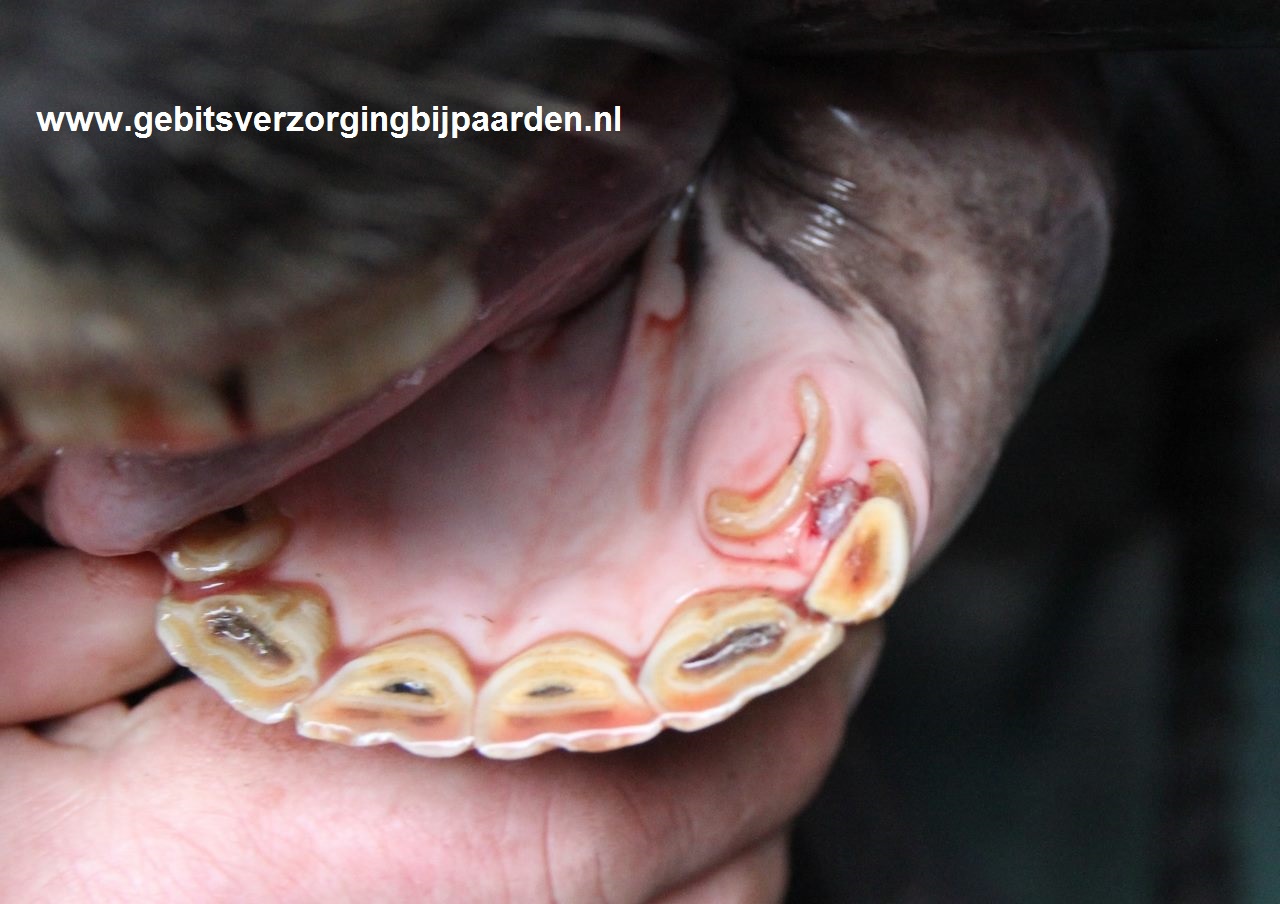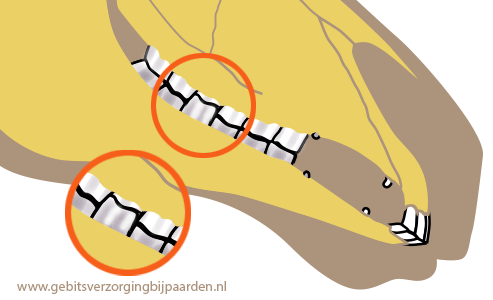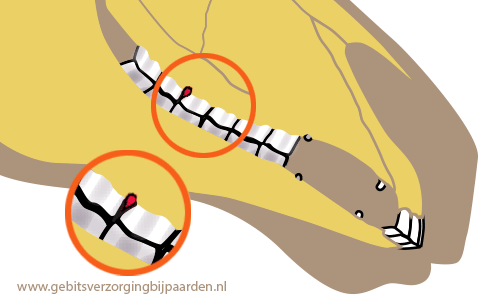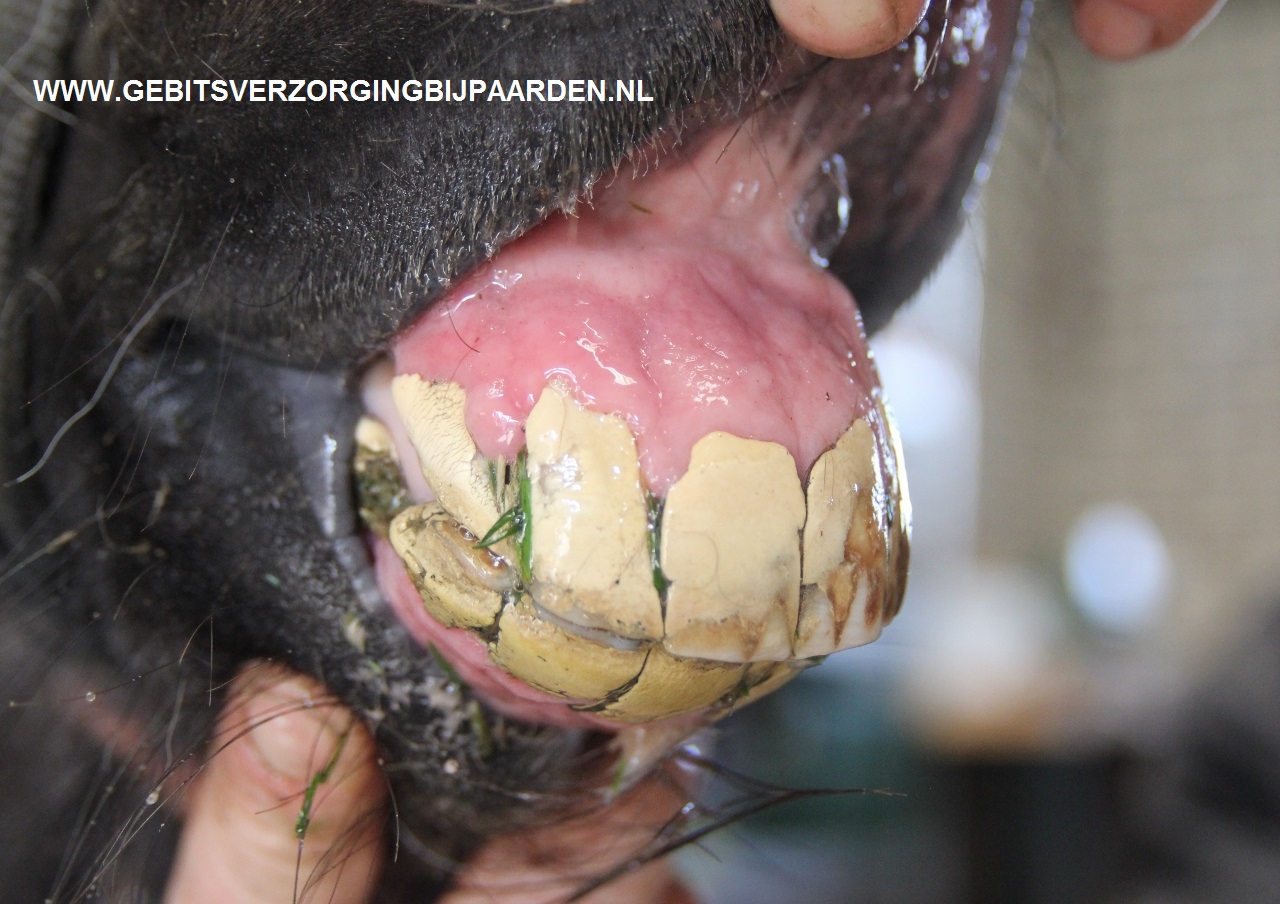Tooth problems
Many things can go wrong with horses teeth, which can be caused by growing, wrong use, or trauma. See below how this can happen.
Horse teeth

The elements of the teeth require a complete book, explain about evolution, its working and care. Therefore its unexplainable in a few sentences. Hereby an explanation about the location of the elements. Additional issues about teeth can be found in my blog.
Incisors
Incisors l01-I03. These teeth are found on the front side, behind the horses’ lip. The incisors come in as baby teeth in the mouth, and later on, they are supplanted by the permanent incisors. A horse has 6 incisors in the lower jaw and 6 incisors in the upper jaw.
Hooks
Behind the incisors we will find hooks in the horse’s mouth. Usually these teeth come through around the age 4,5-5. They are placed a few centimeters behind the last tooth, in which the cutting elements in the upper jaw are usually positioned a little behind the lower hook teeth. In about 5% of the mares we find hooks.
Interdental Space
Then comes the interdental space, where we choose the place the bit in its mouth. This space is for the rider extremely important, but often underestimated in the terms of sensitivity. The skin over the lower jaw is thin, and if reckless, it can be damaged easily. Injury makes it impossible to give the horse the correct training. Therefore, caution is advised.
Molars
Next you will come across the molars. You will find wolf teeth in about 20-30% of all horses. This small element is a left over from the horse’s evolution. Horses used to have a bigger row of molars when the horse had to masticate much more rough feed like branches and leaves. Meanwhile, the row of molars of today’s horse is composed of six elements in which the first 3 elements, like the pre-molars appear in the mouth and are exchanged between the ages of 2,5-4 years old for the permanent molars. Sometimes we find horses with an element too many, Hyperdontia. Even too few elements is possible, here we speak of Hypodontia.
Persistent deciduous incisors and pre-molars

We come across persistent deciduous incisors often. Persistent teeth are teeth that are loose, but will not come out. If they are loose, it is recommended to remove them as soon as possible. At a young age, the final incisors can then, still migrate to their proper position causing diastema to still close in time, and avoid any problems. Caps are the remains of the deciduous teeth. Most horses will lose these caps without human intervention. However, it may be possible that a cap becomes lose and will cause trouble. This can lead to a horse refusing to eat or showing clear signs of pain. Often these patients can easily be assisted with a simple dental treatment.
to top of pageHooks on the third incisor

Incisors can get several different disorders in which hooks on the last elements 03 is most common. You will see the name échancrure or “dove tail” regularly, even on my dental chart. We seek to replace these names in the future.
to top of pageOverbite or underbite

Overbite (parrot mouth / brachygnathism) or underbite (monkey mouth / prognathism) is fairly well known and common in miniature horses and Shetland ponies, with this condition, they are often excluded from being registered in the pedigrees
to top of pageEnamel points

Enamel points originate from the shape of the molars, and emerge in the upper jaw on the cheek side [buccal], and on the lower jaw on the tongue side. [lingual]. Depending on the wave pattern of the so-called singulae, and the presence of the amount of cement, can cause more or less trouble. In performance horses cheek lesions occur often as a result of the tack that is being used, especially the noseband and teeth shape create the problem.
to top of pageHooks

Hooks are found on the first and last molar in a row on the lower and upper jaw. Hooks are often the reason for diastema for the molar, because of the extra pressure of its position. It can also cause injuries in layers of the palate depending on its position, and obstacle in the forward-backward movement of the jaw. Hooks on the front molars often cause cheek lesions.
Hooks on the back molar are often a bigger restraint than hooks on the front, because there is less joint operation. These hooks will cause a big wad in its mouth leading to pain. We also see this with young horses that they have hooks against their baby teeth. Another reason to start early with regular dental checkups.
to top of pageRamps

Ramps are like family of the hooks. Consequences are therefore the same or even worse. We are talking about ramps, if there is more than 1/3 of the chewing area affected. Treatment is needed to avoid future problems.
to top of pageStepped Molars

Stepped Molars can be caused by a tooth fracture or a broken tooth, and can be clearly seen by the increase of the opposite element(s). The element will no longer wear because the opposite element is missing. This issue causes mechanical barriers in the sideways, forward and backwards movement. It is necessary to remove an increased chance of this issue by getting a recommended yearly dental checkup.
to top of pageWave complexes

Wave complex teeth goes up and down and makes a wavy curve in the row of molars. It can be caused by a stepped molar, and also some other reasons. Treatment is often not possible. Most often repetitive attention is required.
to top of pageSheared Molar table
Sheared Molar table is a deviation in the angle of the lower and upper teeth. If this angle is bigger than 25 degrees, we speak of a sheared molar table. The angle can be up go to 50-60 degrees, because of this, a sideways chew movement is impossible. It often leads to the horse trying to save this side. Treatment is often increased to a 6 month check up until correction.
to top of pageDiastema

Diastema is a space between the adjoining elements where feed is easily collected, and can be shifted by pressure of the opposite element. This is one of the most painful conditions for a horse, yet it does not always cause trouble feeding. If a horse has feeding problems it can be seen by the dropping of feed. The problem may manifest itself at any age, but is most often found with older horses. The problem is often periodontitis, an inflammation of the gums. In extreme conditions it can lead to the loss of an element.
to top of pageTooth decay
Tooth decay, also known as cavities or caries, is a result of fermentation of sugars in the diet with bacteria present in the oral cavity. It is seen in the enamel cups of the 9th and 10th element to the upper jaw, and to a less extend in the 6th element of the upper jaw. There will be a higher risk of future damage, like the occurrence of a molar fracture, because of the damage to the internal structure of the teeth.
to top of pageE.O.T.R.H.

EOTRH is a problem to the incisors that is starting to occur more frequently that I would like to explain it. EOTRH stands for ‘Equine Odontalclastic Tooth Resorption and Hypersementosis’. The root of the tooth is absorbed and the glaze is discomposed. It is possible that the tooth root will increase in growth, because of the growth of cement, which is clearly visible above the invisible crown of the incisors. It’s a painful process and occurs in older horses seen around the age of 15 and older. The process starts at the most outer incisor and spreads its way to the other incisors, sometimes it may be possible that even the hooks are included in this process. It is recommended to remove the elements, if clear pain is shown, and food intake becomes more difficult. The best advise we can give is to have this done at a specialized clinic.
to top of page



